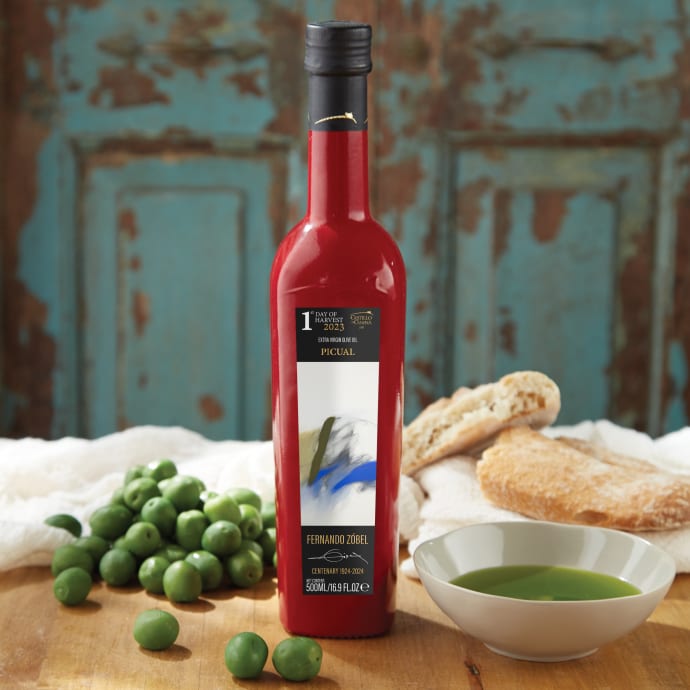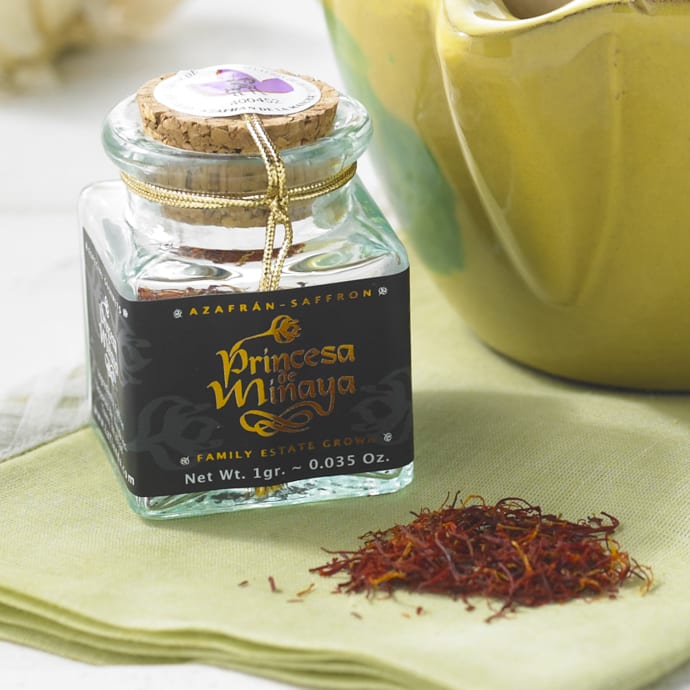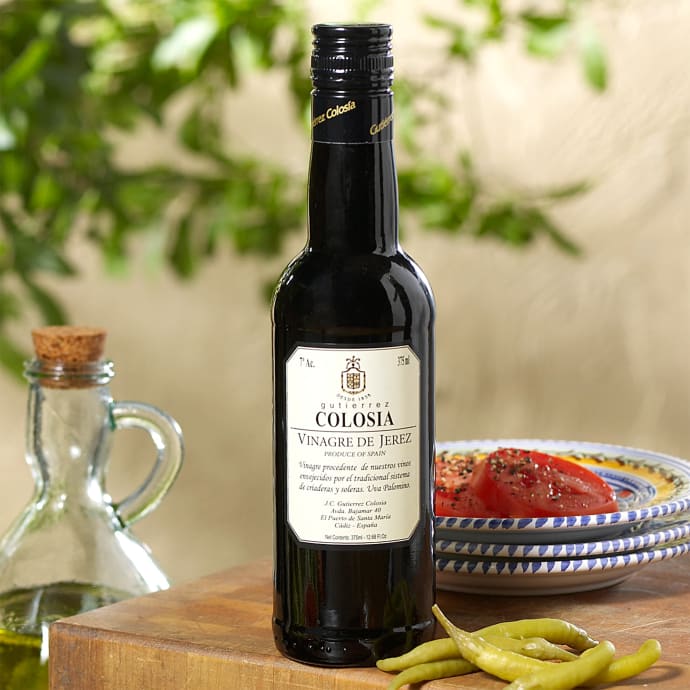
Ibérico Pork, The Extra Virgin Olive Oil Of Meats
Zester Daily
-
July 12, 2013
Caroline J. Beck
“Just let it melt on your tongue,” Jose Martinez-Valero instructed. “It will dissolve into pure flavor.” I placed the tiniest sliver of jamón Ibérico de bellota in my mouth and waited. The finely marbled fat melted like silk, but the finish was remarkably pure, strangely akin to a classic palate cleanser.
As I positioned myself to snare another sample in the elbow-room frenzy of the Culinary Institute of America’s Worlds of Flavor conference at Napa, California, Martinez-Valero hit me with an even bigger surprise. “This fat is just like the very best olive oil, it’s monounsaturated. It comes from a breed of Spanish pig we call the four-legged olive tree,” he said.
And suddenly I understood why the mouthfeel was so familiar. With years of olive oil tasting under my belt, it was easy to recognize the difference between greasy, mouth-coating fat and this high-quality clean finish.
Jamón Ibérico de bellota is familiar to food cognoscenti as the cured form of this extraordinary animal. At prices north of $1,000 for a single ham, it is not widely available in restaurants or markets. But those who can afford it will go to great lengths to find a reputable source, because it is considered one of the finest foods in the world.
At the heart of its difference is that purebred Ibérico pork represents a very old-world approach to one of the tenets of today’s cuisine: a sustainable, simple focus on pure flavor. But like high-quality extra virgin olive oil, purebred Ibérico pork is under siege from unscrupulous distributors who pass off crossbred meats as purebred, elitist pricing and a disappearing ecosystem (needed to support the swine’s unusual eating habits). The species has been on endangered or at-risk lists for years, a dwindling breed supported by a handful of dedicated producers on a lifelong mission to avoid extinction — of the pig, its pastureland and their very livelihoods.
Martinez-Valero represents Ibérico Fresco, one of few Spanish distributors of 100% purebred, acorn-fed fresh Ibérico meat in the United States. Over the din of pork belly- and backfat-crazed chefs at the CIA‘s annual event, he spoke passionately about the plight of this pig and its unique grazing land, the dehesa (forest) of the Iberian peninsula in Spain.
“It is the very definition of sustainable agriculture. The man takes care of the forest, the forest takes care of the pig, and the pig takes care of the man,” explained Martinez-Valero.
Raising Ibérico pigs is an expensive labor of love
Ibérico pigs are not particularly pretty, galloping along with long legs supporting a chunky body. They are best identified by their distinctive black hooves, hence the Spanish name, pata negra. There are many different breeds of Ibérico pigs, ranging from the productive, big Torbiscal to the delicate Entrepelado, but they all have certain traits in common that strain any producer’s pocketbook. Those include litters half the size of crossbreds, production cycles that are three times as long, and particularly expensive eating habits.
In contrast to the ordeals of pigs jammed into cramped pens and pumped full of antibiotics seen in television news reports on the pork industry, the lives of purebred Ibérico pigs seem like a scene straight out of a fairy tale.
By Spanish law, truly purebred (genetically 100%) Ibérico pigs are required to attain at least 40% of their weight grazing exclusively on holm oak acorns during the montanera, or period of fattening between October and January. Each pig is provided 2 hectares (about 5 acres) of personal space to reach its best weight. The high oleic acid content of the acorns and the genetic makeup of the Ibérico help convert the pig’s fat into its distinctive monounsaturated marbling.
“It’s a marvel, a machine for making healthy meat. It’s perfection,” said Lucia Maesso Corral, president of Aeceriber, the Iberian Pig Breeders Association. She represents purebred producers who are fighting an uphill battle against lesser quality, far less expensive crossbred options that are allowed to take the name “Ibérico.” But their passion for truth-in-labeling and authentic, quality production is palpable.
Without question, the better-known cured ham version is amazing. But one taste of the fresh meat they now call “the other red meat” and you will understand the depth of these producers’ dedication. For a dinner party of two, I sautéed a secreto of carne de cerdo ibérico de bellota (acorn-fed Iberico pork shoulder skirt) for no more than two minutes per side, classically medium rare with a deep pink in the center, and sliced it like flank steak. Without exaggeration, it may well be the best meat I’ve ever eaten: succulent, sweet, almost nutty. Good enough that we didn’t have the discipline to stop, finishing off the entire cut with no regrets.
Monastrell’s Ibérico Pork with Manchego Cheese and Saffron
I went straight to the best source I know in Spain for a professional’s opinion of the meat. Chef María José San Román of Monastrell in Alicante, Spain, heralds the pig on her Michelin-starred menu with a simple appetizer that showcases the meat by surrounding it with gentle flavors: a foam of Manchego cheese crowned with spring-fresh watercress.
“Many people only know Ibérico ham in its cured form, but fresh cuts of the pig are extraordinary examples of the best pork Spain has to offer,” San Román said. “Like the Manchego cheese it is paired with, Ibérico pork is quintessential Spanish cuisine.”
Serves 6 to 8 as an appetizer
Ingredients
8 teaspoons (40 ml) extra virgin olive oil (preferably Picual variety), plus more for frying
1 pound (500 g) piece acorn-fed purebred Ibérico shoulder loin (presa) (see note below)
1.7 ounces (50 g) salt
100 mg saffron powder (see note below)
1½ ounces (40 g) each of capers, small gherkins, and finely chopped spring onions
2 teaspoons (10 ml) sherry vinegar
¼ pound (100 g) watercress
7 ounces (200 g) Manchego cheese
6 ounces (175 g) fresh cream
5 ounces (150 g) fresh milk
1 pound (500 g) potatoes, cut into matchsticks with a mandoline
Olive oil for frying
Foam maker, such as the iSi Gourmet Whip Plus
Directions
1. Marinate the pork for 3 hours in 2 cups (500 ml) of water with salt and saffron powder. Pork should be room temperature before cooking. Do not trim excess fat. Pat meat dry to remove excess moisture.
2. Place a frying pan with a little extra virgin olive oil over high heat. Place meat fat side down and sear for three minutes. Turn over and sear for two minutes on the other side until meat is just pink. Let rest for 5 minutes, slice angled strips against the grain and set aside.
3. Prepare vinaigrette by mixing capers, gherkins, spring onions, sherry vinegar and 8 teaspoons of extra virgin olive oil. Add to watercress and toss to coat.
4. Heat cheese, cream and milk until the cheese is melted, but do not boil. Put through a sieve and into the siphon and keep hot.
5. Deep fry the matchstick potatoes in olive oil and drain on tissue paper.
6. Put the potatoes in the center of the plate, layer slices of pork around it and place the dressed watercress salad on top.
7. Surround with the hot cheese foam.
Note
Fresh, acorn-fed 100% Ibérico pork and saffron powder can be found at tienda.com.
Top photo: Ibérico pigs. Credit: Courtesy of Aeceriber
Caroline J. Beck is a freelance food and wine writer and a strategic advisor to specialty food start-ups. Her articles and columns have appeared in such publications as the Santa Ynez Valley Journal, Michigan BLUE -- Michigan's Lakestyle Magazine, and The Olive Oil Source, the world's top-ranked olive oil-related website, where she has served as editor since 2007. Caroline's website, www.carolinejbeck.com, provides common sense advice for enthusiastic entrepreneurs looking to succeed in the specialty foods business.
“Just let it melt on your tongue,” Jose Martinez-Valero instructed. “It will dissolve into pure flavor.” I placed the tiniest sliver of jamón Ibérico de bellota in my mouth and waited. The finely marbled fat melted like silk, but the finish was remarkably pure, strangely akin to a classic palate cleanser.
As I positioned myself to snare another sample in the elbow-room frenzy of the Culinary Institute of America’s Worlds of Flavor conference at Napa, California, Martinez-Valero hit me with an even bigger surprise. “This fat is just like the very best olive oil, it’s monounsaturated. It comes from a breed of Spanish pig we call the four-legged olive tree,” he said.
And suddenly I understood why the mouthfeel was so familiar. With years of olive oil tasting under my belt, it was easy to recognize the difference between greasy, mouth-coating fat and this high-quality clean finish.
Jamón Ibérico de bellota is familiar to food cognoscenti as the cured form of this extraordinary animal. At prices north of $1,000 for a single ham, it is not widely available in restaurants or markets. But those who can afford it will go to great lengths to find a reputable source, because it is considered one of the finest foods in the world.
At the heart of its difference is that purebred Ibérico pork represents a very old-world approach to one of the tenets of today’s cuisine: a sustainable, simple focus on pure flavor. But like high-quality extra virgin olive oil, purebred Ibérico pork is under siege from unscrupulous distributors who pass off crossbred meats as purebred, elitist pricing and a disappearing ecosystem (needed to support the swine’s unusual eating habits). The species has been on endangered or at-risk lists for years, a dwindling breed supported by a handful of dedicated producers on a lifelong mission to avoid extinction — of the pig, its pastureland and their very livelihoods.
Martinez-Valero represents Ibérico Fresco, one of few Spanish distributors of 100% purebred, acorn-fed fresh Ibérico meat in the United States. Over the din of pork belly- and backfat-crazed chefs at the CIA‘s annual event, he spoke passionately about the plight of this pig and its unique grazing land, the dehesa (forest) of the Iberian peninsula in Spain.
“It is the very definition of sustainable agriculture. The man takes care of the forest, the forest takes care of the pig, and the pig takes care of the man,” explained Martinez-Valero.
Raising Ibérico pigs is an expensive labor of love
Ibérico pigs are not particularly pretty, galloping along with long legs supporting a chunky body. They are best identified by their distinctive black hooves, hence the Spanish name, pata negra. There are many different breeds of Ibérico pigs, ranging from the productive, big Torbiscal to the delicate Entrepelado, but they all have certain traits in common that strain any producer’s pocketbook. Those include litters half the size of crossbreds, production cycles that are three times as long, and particularly expensive eating habits.
In contrast to the ordeals of pigs jammed into cramped pens and pumped full of antibiotics seen in television news reports on the pork industry, the lives of purebred Ibérico pigs seem like a scene straight out of a fairy tale.
By Spanish law, truly purebred (genetically 100%) Ibérico pigs are required to attain at least 40% of their weight grazing exclusively on holm oak acorns during the montanera, or period of fattening between October and January. Each pig is provided 2 hectares (about 5 acres) of personal space to reach its best weight. The high oleic acid content of the acorns and the genetic makeup of the Ibérico help convert the pig’s fat into its distinctive monounsaturated marbling.
“It’s a marvel, a machine for making healthy meat. It’s perfection,” said Lucia Maesso Corral, president of Aeceriber, the Iberian Pig Breeders Association. She represents purebred producers who are fighting an uphill battle against lesser quality, far less expensive crossbred options that are allowed to take the name “Ibérico.” But their passion for truth-in-labeling and authentic, quality production is palpable.
Without question, the better-known cured ham version is amazing. But one taste of the fresh meat they now call “the other red meat” and you will understand the depth of these producers’ dedication. For a dinner party of two, I sautéed a secreto of carne de cerdo ibérico de bellota (acorn-fed Iberico pork shoulder skirt) for no more than two minutes per side, classically medium rare with a deep pink in the center, and sliced it like flank steak. Without exaggeration, it may well be the best meat I’ve ever eaten: succulent, sweet, almost nutty. Good enough that we didn’t have the discipline to stop, finishing off the entire cut with no regrets.
Monastrell’s Ibérico Pork with Manchego Cheese and Saffron
I went straight to the best source I know in Spain for a professional’s opinion of the meat. Chef María José San Román of Monastrell in Alicante, Spain, heralds the pig on her Michelin-starred menu with a simple appetizer that showcases the meat by surrounding it with gentle flavors: a foam of Manchego cheese crowned with spring-fresh watercress.
“Many people only know Ibérico ham in its cured form, but fresh cuts of the pig are extraordinary examples of the best pork Spain has to offer,” San Román said. “Like the Manchego cheese it is paired with, Ibérico pork is quintessential Spanish cuisine.”
Serves 6 to 8 as an appetizer
Ingredients
8 teaspoons (40 ml) extra virgin olive oil (preferably Picual variety), plus more for frying
1 pound (500 g) piece acorn-fed purebred Ibérico shoulder loin (presa) (see note below)
1.7 ounces (50 g) salt
100 mg saffron powder (see note below)
1½ ounces (40 g) each of capers, small gherkins, and finely chopped spring onions
2 teaspoons (10 ml) sherry vinegar
¼ pound (100 g) watercress
7 ounces (200 g) Manchego cheese
6 ounces (175 g) fresh cream
5 ounces (150 g) fresh milk
1 pound (500 g) potatoes, cut into matchsticks with a mandoline
Olive oil for frying
Foam maker, such as the iSi Gourmet Whip Plus
Directions
1. Marinate the pork for 3 hours in 2 cups (500 ml) of water with salt and saffron powder. Pork should be room temperature before cooking. Do not trim excess fat. Pat meat dry to remove excess moisture.
2. Place a frying pan with a little extra virgin olive oil over high heat. Place meat fat side down and sear for three minutes. Turn over and sear for two minutes on the other side until meat is just pink. Let rest for 5 minutes, slice angled strips against the grain and set aside.
3. Prepare vinaigrette by mixing capers, gherkins, spring onions, sherry vinegar and 8 teaspoons of extra virgin olive oil. Add to watercress and toss to coat.
4. Heat cheese, cream and milk until the cheese is melted, but do not boil. Put through a sieve and into the siphon and keep hot.
5. Deep fry the matchstick potatoes in olive oil and drain on tissue paper.
6. Put the potatoes in the center of the plate, layer slices of pork around it and place the dressed watercress salad on top.
7. Surround with the hot cheese foam.
Note
Fresh, acorn-fed 100% Ibérico pork and saffron powder can be found at tienda.com.
Top photo: Ibérico pigs. Credit: Courtesy of Aeceriber
Caroline J. Beck is a freelance food and wine writer and a strategic advisor to specialty food start-ups. Her articles and columns have appeared in such publications as the Santa Ynez Valley Journal, Michigan BLUE -- Michigan's Lakestyle Magazine, and The Olive Oil Source, the world's top-ranked olive oil-related website, where she has served as editor since 2007. Caroline's website, www.carolinejbeck.com, provides common sense advice for enthusiastic entrepreneurs looking to succeed in the specialty foods business.
Other Press
This Classic Garlic Keeper Is the One Thing I Made Sure I Brought Back from Spain
The Kitchn
-
July 10, 2024
That's How the Light Gets In
Defense Visual Information Distribution Service
-
April 20, 2024
See How Jamón Gets Made in the Heartland of Spanish Pork
Washington Post
-
April 16, 2024
No Ortolans Were Hurt During the Making of This Film
New York Times
-
December 12, 2023
Featured Products

'First Day of Harvest' Picual Extra Virgin Olive Oil
OO-62
$69.00$69.00

Premium Powdered Saffron by Syren – 10 Single Dose Packets
SN-12
(5)
$22.00$22.00

Princesa de Minaya Saffron, D.O. La Mancha
SN-09
(53)
$19.00$19.00

Barrel Aged Sherry Vinegar by Gutierrez Colosia
VN-30
$12.00$12.00
 NEW
NEWAcorn-Fed Ibérico Pork Grilling Sampler
IP-14
$159.00$159.00





